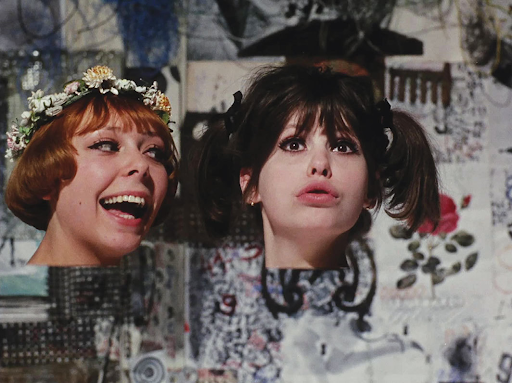Two insane comedies to distract you from the pain
They’re both insanely good AND insanely short!

Marie and Marie (Jitka Cerhová and Ivana Karbanová) goof around while their heads are detached from their bodies in “Daisies”.
August 16, 2021
The school year is once again hurtling towards us at a rate which can only inspire anxiety. There’s only so much time left before we’ll be subjected to the usual drudgery and expectations of regular school life, so we have to enjoy ourselves in the meantime. To help you do this, I’ve compiled a pair of fantastic comedies which will brighten your day in less than 80 minutes! Since I like themes, these two films are not only linked by their genre and length, but by their abject insanity. While one of these comedies is insane on a stylistic level, the other is insane for its death defying stunts. Enjoy!
Stylistically Insane: “Daisies” (1966)
Director: Věra Chytilová
76 minutes
Immediately banned by the Czechoslovakian government for wasting food (and in the final moments ridiculing government officials who would do so), “Daisies” is a film first and foremost about breaking rules. The premise is simple: two girls named Marie have become disillusioned with the world, so they decide that if the world is so bad, then they too must be bad. What follows from there is a veritable odyssey of mischief where the two Maries break all the rules, ranging from societal taboos on excess to the role of women in relationships to the very foundations of reality. This is done through a dizzying array of different color palettes and editing techniques that sometimes even resort to cutting the very film to ribbons, which create an atmosphere of unbridled tomfoolery.
The blatant weirdness-for-the-sake-of-it that “Daisies” indulges in is what I feel makes it still resonate today. While the humor of the movie largely stems from the pure audacity of making it in such a male-dominated work-obsessed society, there are sequences here which I wouldn’t be surprised to see in a more abstract YouTube video. One example is the iconic scene where the two Maries use scissors to cut up bananas, sausages, and various other similarly shaped food items while the blonde Marie also talks on the phone with a desperate sugar daddy. If you think that sounds unsubtle, that’s precisely the point. “Daisies” is rarely ever concerned with the intricate subtleties which make up your stereotypical arthouse film. If the frame is completely blue, it’s not to communicate blue feelings, it’s just because the director wanted blue. If the heads of the Maries are floating in midair, it’s just because it looked fun. While this might seem lazy in most other films, I think it just contributes more to the hilarious anarchic tone.
This doesn’t mean that the film is completely without a point, though. Like I said before, much of this film’s merit comes from its very existence, especially considering the overarching messages it conveys. While scenes like the ones where the Maries toy with rich men on fake dates or the climactic food fight (perhaps the best ever captured on film) might not have much symbolic purpose in relation to the mental state of the characters, their necessity to the overall message of the film is indispensable. This was a state funded film that had themes which ran completely counter to the ideals of the state, going so far as to have a dedication “TO THOSE WHO GET UPSET ONLY OVER A STOMPED-UPON BED OF LETTUCE”, which points out the hypocrisy of a government that is obsessed with maintaining order in society through movies instead of focusing on actual problems.
This film is a bold, revelatory romp which completely sympathizes with two women who would be the scourge of the nation if real and is told in a way which was even more controversial than the way the heroines think. I highly recommend this film as a piece of important Czech history, a landmark feminist film, or just an incredibly weird comedy to laugh at with friends. You can catch the film on HBO Max.
Insane Stunts: “The General” (1926)
Director: Buster Keaton, Clyde Bruckman
79 minutes
Before Tom Cruise started jumping off helicopters and George Miller started crashing more cars than an automobile testing facility, Buster Keaton did it all… and better. In “The General”, Keaton meticulously crafts some of the most dangerous and impressive action-comedy set pieces ever devised in which he has to perform those death defying stunts with a stone-cold composure: the mark of a master daredevil. While the stunts are anything but, the story is a relatively simple one: a Confederate train engineer has to rescue his belle and his train (the eponymous “General”) after the Union has stolen them.
This leads me to the thing which might be the hardest sell for most contemporary audiences: framing the Confederacy as the protagonists of your story is generally frowned upon in the modern day. While I completely understand if that alone is enough for you to completely disregard the film – you would never see me defending blatant racism because of filmmaking – I’d like to give a little bit of context for why I personally can put that aside in this movie. For one, this film does not endorse the ideology of the Confederacy. While it doesn’t challenge them, which I would’ve appreciated, none of the malignant tumors masquerading as ideas that the Confederacy was more than happy to own are ever really spoken about, let alone approved of by the filmmakers. This is probably because of the second reason I’m ok with this movie: the protagonists weren’t even supposed to be Confederates. While the original true story which “The General” is based on starred Union officials, the American public generally frowned upon demonizing the South in 1926 due to the Civil War’s relative recency. This general attitude led to the decision to make the film about the South – if only aesthetically – because the picture was already going to be one of the most expensive ever made, so risking the budget even more by alienating the audience wasn’t on the table. In summation, I will actually let the “it was a product of its time” argument pass.
Now that I’ve given my two cents on why I don’t think this film is inherently problematic, I can finally explain why I think this movie is fantastic. For one, on a purely comedic level, I think “The General” succeeds with flying colors. Each gag is carried out with grace and precision and each comedic element not only works on its own, but simultaneously sets up future jokes – whether they’re in the next couple of seconds or in the next half of the movie. Combined with Keaton’s trademark stoicism, this makes for a comedic experience which I can only describe as a mixture between a Looney Toons cartoon and a great Bill Murray role. When you aren’t laughing, you’re likely going to be in awe of the way that the action plays out. No matter which way Keaton is putting himself in moral peril, whether it be by firing mortars off train cars or pulling railroad ties out of the ground with the real threat of being run over by a train, the action is always easy to follow and, of course, Keaton remains stoic.
I believe that this movie is really one of the great gateway drugs into silent cinema. It has very few intertitles, and since it relies so much on slapstick, its humor hasn’t aged a day. If you want to be wowed by an action comedy in a way that very few made since have been able to do, give “The General” a chance. It’s a blast.
You can watch the film here: https://www.youtube.com/watch?v=m33VfG6-4vQ








